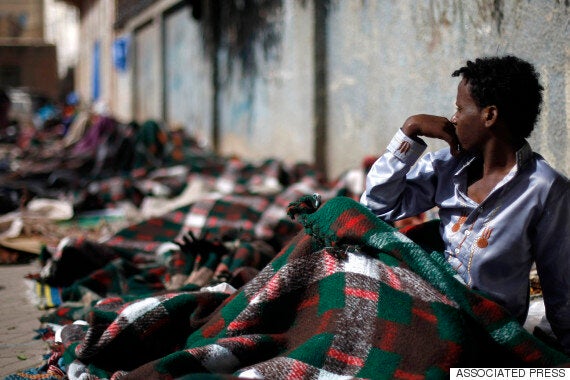Asylum seekers are people who move to a new country and apply to stay, seeking refuge from persecution.
There are an estimated 126,000 refugees currently living in the UK, according to the British Red Cross.
More than half of the world's asylum seekers came from just five countries in 2014. These were Syria, Afghanistan, Somalia, Sudan and South Sudan.

An Eritrean asylum seeker sits among others sleeping on the sidewalk in Sanaa, Yemeni
The history of asylum
Historically, people seeking refuge from persecution would hide in churches, where they could not be harmed without their persecutors facing the wrath of God.
In 511 AD this "right to asylum" was codified in French law, which is one of the reasons why churches are sometimes referred to as sanctuaries.
Modern asylum came about in 1951 when a UN refuge convention was formed, following WW2.
It stated that an asylum seeker, or refugee, has "a well founded fear of persecution", on account of their race, religion, nationality, membership of a particular social group or political opinion."
How does it work in the UK?
Decisions on asylum and human rights claims made in the UK are made by the UK Border Agency, which is an agency of the Home Office.
Although some asylum seekers might enter the UK illegally, once they have applied for asylum they are no longer ‘illegal’.
The right to claim asylum is in international law. Governments are obliged to provide protection to people who meet the criteria for asylum. The UK has signed these international laws and they are part of UK legislation.
Three pieces of international law can be used to support an asylum application in the UK:
1. 1951 Geneva Convention Relating to the Status of Refugees
2. 1950 European Convention on Human Rights (ECHR)
3. European Union Asylum Qualification Directive
How are decisions on Asylum made?
Decisions on asylum are made by a contributing number of factors. However guidance can be found under the 1951 Geneva convention and they state that decisions are made for the following reasons:
- The person would be at risk of experiencing such persecution in the future if they were returned
- The harmful treatment the person fears amounts to ‘persecution’
- The person’s fear of such persecution is ‘well-founded’
- The persecution is for one of the five reasons specified in the Convention
- The person could not find protection in another part of their country
If the application is rejected, the seeker has a right to submit a second claim.